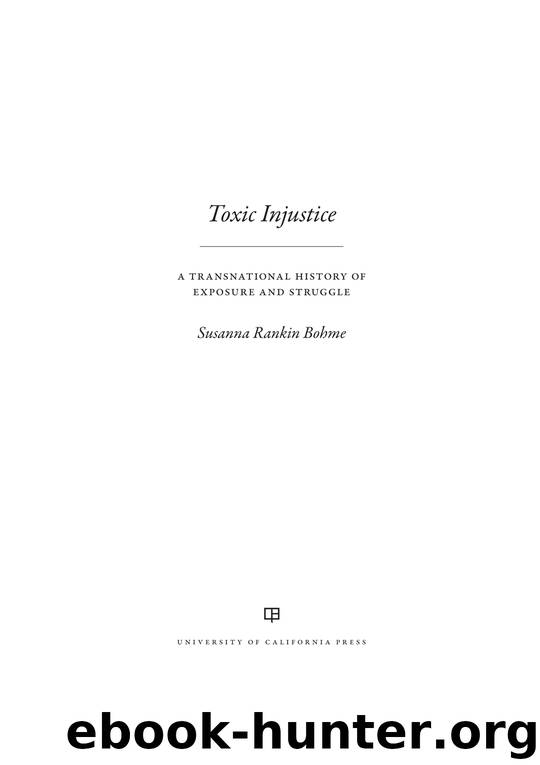Toxic Injustice by Bohme Susanna Rankin

Author:Bohme, Susanna Rankin
Language: eng
Format: epub
ISBN: 9780520278981
Publisher: University of California Press
SIX
National Law, Transnational Justice?
IN NOVEMBER 1999, THE MANAGUA daily El Nuevo Diario reported that hundreds of DBCP-affected agricultural workers were protesting in the capital: “Under the torrid sun of the capital, a hundred marchers carrying giant crosses, placards and banners, arrived with their faces sweating, their feet swollen, and crying in unison, ‘We want Justice! End the exploitation of the transnational Standard Fruit Company!’”1 Seven days before, the ex-banana workers and their family members had gathered in Chinandega, a town of about 120,000 in northwest Nicaragua, at the center of the hot and humid agricultural region where United Fruit and Standard Fruit had operated in the 1960s and 1970s, respectively.2 They had come together to make the almost 90-mile journey to Managua—not by car or by bus, but on foot.
Like their Costa Rican counterparts, Nicaraguan afectados frustrated at the stalled progress and unsatisfactory outcomes of their legal cases had turned to protest aimed at their own government. But while the Costa Rican afectado movement placed the burden of recompense on the state, Nicaraguans firmly linked national politics to a transnational struggle. Mobilizing in a small, relatively powerless nation during a period of globalization in which state power was generally understood to be on the decline, Nicaraguans nevertheless hoped to use legislation and litigation at the national level to change the rules—and hopefully the outcome—of transnational litigation, and hold transnational corporations accountable for the disease they had caused.
The Nicaraguan strategy called the fruit and chemical corporations’ bluff. The corporations had repeatedly argued that Nicaragua was an adequate forum for DBCP litigation—and now Nicaraguans welcomed them, but on local terms. The law at the center of the Nicaraguan afectados’ movement set rules on causation that broadly defined DBCP disease, lowered the burden on plaintiffs, and provided for compensation similar to what U.S. plaintiffs’ DBCP suits had brought in that country. Facilitating litigation in Nicaragua, the law simultaneously opened the door to successful litigation in the United States by emptying out the primary rationale for FNC dismissals—that is, defendants’ desire to litigate in a forum with weak tort laws.
Nicaraguan Law 364, called the “Special Law for Banana Workers Victimized by the Use of DBCP-Based Pesticides,” passed in 2000 and soon generated multimillion dollar verdicts in favor of afectados and opened the way for new lawsuits in the United States. In the wake of their successes, however, Nicaraguan afectados and their attorneys faced the full brunt of corporate responses. Using a timeworn strategy of U.S.-based corporations abroad, defendant corporations called upon the political power of the United States in an attempt to reverse the law. In U.S. courtrooms, they mobilized stereotypes of Latin American corruption. And, faced with mounting verdicts in Nicaragua, they turned to a newer strategy, invoking provisions of a trade agreement to thwart the Nicaraguan state’s ability to carry out its own laws. Afectados mobilized nationally, using mass protests, anti-imperialist rhetoric, and visual representations of physical suffering in their struggle for transnational justice.
Download
This site does not store any files on its server. We only index and link to content provided by other sites. Please contact the content providers to delete copyright contents if any and email us, we'll remove relevant links or contents immediately.
Man-made Catastrophes and Risk Information Concealment by Dmitry Chernov & Didier Sornette(5614)
The Revenge of Geography: What the Map Tells Us About Coming Conflicts and the Battle Against Fate by Kaplan Robert D(3938)
Zero Waste Home by Bea Johnson(3625)
In a Sunburned Country by Bill Bryson(3344)
Good by S. Walden(3330)
COSMOS by Carl Sagan(3324)
The Fate of Rome: Climate, Disease, and the End of an Empire (The Princeton History of the Ancient World) by Kyle Harper(2845)
Camino Island by John Grisham(2707)
A Wilder Time by William E. Glassley(2667)
Organic Mushroom Farming and Mycoremediation by Tradd Cotter(2551)
The Ogre by Doug Scott(2486)
Human Dynamics Research in Smart and Connected Communities by Shih-Lung Shaw & Daniel Sui(2421)
Energy Myths and Realities by Vaclav Smil(2361)
The Traveler's Gift by Andy Andrews(2289)
9781803241661-PYTHON FOR ARCGIS PRO by Unknown(2254)
Inside the Middle East by Avi Melamed(2220)
Birds of New Guinea by Pratt Thane K.; Beehler Bruce M.; Anderton John C(2162)
A History of Warfare by John Keegan(2080)
Ultimate Navigation Manual by Lyle Brotherton(2029)
